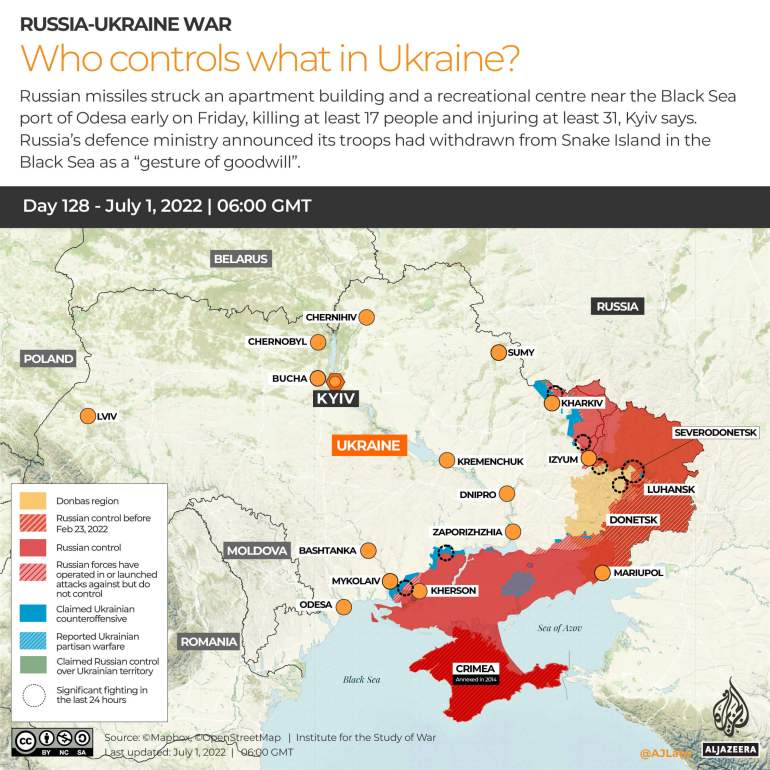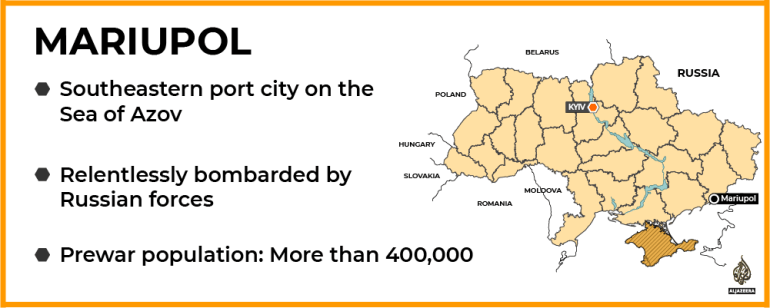What is life like in Russia-occupied areas of Ukraine?
Taras #Taras

Kyiv, Ukraine – It wasn’t a knock, it was loud banging – at about 7:30 on a recent Saturday morning.
Taras opened the door of his two-bedroom apartment in Kreminna, a town in Ukraine’s southeastern Luhansk region that was taken over by Russia in late April, to see three gun-toting soldiers in camouflage.
“Do you have a garage on the corner?” the oldest of them, a redhead in his late 20s, asked Taras imperatively.
Without waiting for his answer, the soldier continued: “Open it up.”
He was talking about a group of three dozen garages built in the early 1980s, an area which had become an informal club, where men could have a drink, crack a joke and play backgammon or chess.
But to the Russian occupiers, the garages were a source of danger, a younger, less strict soldier told 53-year-old Taras on the way, and they needed to check each for arms and explosives.
“They looked inside, checked the basement and left without saying a word,” Taras, who requested Al Jazeera withhold his last name because he “doesn’t want to be shot.”
 (Al Jazeera)
(Al Jazeera)
They only thing of interest they saw and took away was a three-litre jar with cucumbers that Taras’s wife had pickled in vinegar and tomato juice.
Taras got lucky.
His neighbour had his sky-blue Lada Priora “confiscated” and was beaten and left bruised after he hesitated to hand over the car key for a split second.
On Monday, after the capture of the Luhansk region, media outlets in Russia aired interviews with residents of Lysychansk who thanked Moscow for “liberating” them and claimed Kyiv’s forces were inhumane.
But people Al Jazeera spoke to had rather different views.
They say Russian occupiers beat, torture and loot them – and are instructed to provide help only in the areas that Moscow wants to rule directly.
“They don’t treat us like humans. They say they came to liberate us – from what? From our property? From our lives?” Taras told Al Jazeera via a messaging app.
“Liberation” is the key word the Kremlin uses when describing what it calls the “special operation in Ukraine”.
In Kremlin-speak, Ukraine had to be “liberated” from its “neo-Nazi” regime, and the eastern and southern Ukrainian regions where the majority of the population speaks Russian needed a “liberation” from “Ukrainian nationalists”.
In reality, in the occupied areas of Ukraine, Russia pursues three different policies.
The first one is being implemented in places such as Kreminna in the Luhansk and Donetsk regions, known collectively as the Donbas, that had already been partially controlled by separatists since 2014, says Kyiv-based political analyst Aleksey Kushch.
“They use the scorched earth tactic here, a big population is seen as an unnecessary social burden,” he told Al Jazeera.
Moscow prefers to send younger residents of the Donbas to Russia to repopulate its regions with low birthrates, bad local economies, and excessive alcoholism and crime.
More than a million Ukrainians have been “deported” to Russia from the Donbas, including the city of Mariupol, Ukrainian officials said.
The restoration of plants and factories in occupied Donbas, Ukraine’s former industrial pillar, is of no interest to Moscow. Russia simply needs to declare the “liberation” of areas that would later become part of the separatist statelets – the so-called “people’s republics” of Donetsk and Luhansk known as DPR and LNR – that are fully dependent on Russia economically and politically, Kushch said.
A stark example of this strategy is the way Russia operates in Mariupol, a former industrial hub on the Sea of Azov that had a population of more than 400,000 before the war.
After merciless, incessant pummelling between late February and April, it is now home to tens of thousands, mostly the elderly who live without electricity, running water and healthcare.
They “cook, look for firewood, collect water and live” outdoors because their shelling-damaged apartment buildings may collapse any minute and bury them alive, said Petro Andryushchenko, an adviser to Mariupol’s mayor Vadym Boychenko, who left the city before Russia’s takeover.
“The worst thing is that people are getting used to it. They compare [their living conditions] not to what was before the war but to [what happened] in February – April. With their lives in the cold basements under fire,” Andryushchenko said in a Telegram post in mid-June.
The second strategy is used in the areas Russia plans to hold on to directly – namely, the southern regions of Kherson and Zaporizhia, and in parts of the northeastern Kharkiv region adjacent to the Russian border.
“There are attempts to create loyalty … they plan fictional ‘referendums’” to declare their residents’ “determination” to join Russia, analyst Kushch said.
In Kherson, despite hundreds of alleged abductions of pro-Ukrainian activists, most in the area are being cajoled into submission with food handouts and the promises of tax breaks, higher pensions and other perks.
Even critics of their policies admit that their efforts are aimed at appeasing the masses.
“They quietly, calmly help people. One can take as much flour, grain, sugar, all in sacks. If it wasn’t for them, there would have been famine,” Halyna, a pro-Kyiv resident of Kherson, told Al Jazeera.
Last Wednesday, Kremlin-appointed officials in Kherson said they were preparing a “referendum” to join Russia.
Meanwhile, a third strategy is being used in areas where Russia did not try to create loyalists and relied on “terror and mass crimes towards civilians,” Kushch said.
Ukrainian officials say that more than 1,000 people have been killed in the towns and villages northwest, north and northeast of Kyiv between late February and early April, after Moscow retreated from the area after realising it would not risk street fights to seize the capital.
Many civilians were reportedly tortured, raped and shot dead in the back of their heads.
Some were killed just for fun, said a survivor who was beaten and doused with diesel fuel in late March.
“They said: ‘Let’s set him on fire and send [him] back to his people,’” Viktor, a resident of Bucha, where most of the killings had taken place, told Al Jazeera in early April.
He survived only because shelling from the Ukrainian side forced his tormentors into a bomb shelter while he managed to escape.
Another reason why atrocities were so widespread, cruel and arbitrary is because of the narrative on Kremlin-controlled television networks that has for years portrayed Ukrainians as “neo-Nazis” who approve of the alleged “genocide” of Russian-speaking residents of the Donbas.
Another survivor described the look on the faces of three Russian soldiers who stormed into her house in the village of Myrotske 40 kilometres (25 miles) northwest of Kyiv.
“They seemed full of hatred to Ukraine since they had been born,” child psychologist Rivil Kofman told Al Jazeera in mid-March.
Kofman and her son David managed to leave the village after hiding for days in their ice-cold basement, observing the duels between Russian tanks and Ukrainian artillery – and witnessing the killing of their escaping neighbours in their cars.
Unsurprisingly, residents of Russia-occupied areas meet Ukrainian servicemen as their true “liberators”.
“They cried, they hugged us, saying, ‘Oh, my dearest ones, thank you,’” said Maksim Butkevych, a Ukrainian human rights advocate who volunteered to join the Ukrainian army, and took part in the battles to retake Kyiv suburbs.
“One old-timer even offered me moonshine, and I had to tell him, ‘Daddy, I am on duty!’” Butkevych, who was taken prisoner in the Donbas last week, told Al Jazeera in mid-May.